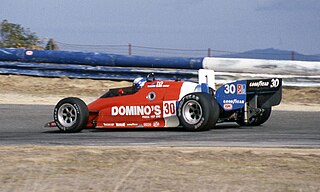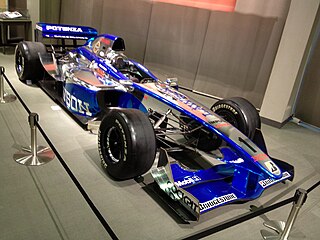Related Research Articles

The Lola T290, and its evolutions, the T292, T294, T296, T297, T298, and T299, are a series of Group 5 Sports 2000 prototype race cars, designed and developed by Bob Marston, John Barnard, Patrick Head, and Eric Broadley, and built by British manufacturer and constructor Lola, for European 2-Litre Championship sports car racing series, between 1972 and 1981.
The Lola T100 is a Formula 2 single-seater entered by German BMW team for the 1967 German Grand Prix, the seventh round of the 1967 Formula One World Championship. Designed by British manufacturer Lola Cars, led by engineer Eric Broadley, the T100 was raced by Britons David Hobbs and Brian Redman. A version adapted to the technical regulations of Formula 1 was also driven by German Hubert Hahne.
The Lola T102, also known as the BMW T102, is a Formula 2 car, designed, developed and built by Lola Cars, under the leadership and guidance of Eric Broadley. It competed between 1968 and 1969. It entered and competed in one Formula One Grand Prix; the 1968 German Grand Prix; where German driver Hubert Hahne finished in tenth place.
The Lola T150, and it's the deriatives, the T152 and T153, were open-wheel racing car chassis, designed and built by Lola Cars to compete in USAC IndyCar racing series, between 1968 and 1970. The T150 and T153 were powered by the 159

The Lola T90 is a highly successful and competitive open-wheel racing car chassis, designed and built by Lola Cars to compete in USAC IndyCar racing series, that successfully won the 1966 Indianapolis 500, being driven by Graham Hill. It was powered by either the 425–500 hp (317–373 kW), naturally-aspirated, 256 cu in (4.20 L), Ford Indy V-8 engine, or the 168 cu in (2.75 L), 520 hp (390 kW), Offenhauser 4-cylinder turbo engine.
The Lola T160 is a series of purpose-built Group 7 sports prototype race cars, designed and developed by British chassis manufacturer Lola Cars, specifically to compete in the Can-Am series in 1968. It was the successor to the competitive T70, sharing similar design knowledge and cues. Lola built the chassis, constructed out of fiberglass, and molded into an aluminum monocoque. This meant the car was light was lightweight, weighing only 670 kg (1,480 lb). The chassis was designed to accept a small-block engine, but most cars were powered by either the Chevrolet ZL1 or the Ford FE "big-block" motors, generating about 625–750 hp (466–559 kW); mated to a 4-speed or 5-speed Hewland L.G.500 or L.G.600 manual transmission. This made the cars very fast, with a notably excellent power-to-weight ratio. It was used in active competition until 1971, and was succeeded and used alongside the new T220 in 1970.
The Lola T530 is a purpose-built Can-Am sports prototype, designed by British manufacturer Lola Cars in for the revived Can-Am series 1980. It was very successful, winning 7 of the 9 races in its first season of competition alone, and gave Patrick Tambay the championship with Carl A. Haas racing Team. Geoff Brabham won the championship in 1981; despite only winning 2 races. It was used in Can-Am racing until 1983. It was later used in the international Interserie racing series, and the British Thundersports racing series, between 1984 and 1988. Between 1980 and 1988, it scored a total of 32 race wins, and 43 podium finishes; a very impressive tally indeed. As with all other full-size Can-Am cars of the time, it used a mid-mounted 5-liter, naturally-aspirated, Chevrolet V8 engine. A total of 10 chassis' were built.

The Lola T800 is an open-wheel racing car chassis, designed and built by Lola Cars that competed in the CART open-wheel racing series, for competition in the 1984 IndyCar season. The T800 was the Newman Haas Racing team's emergency vehicle in the CART series. The Newman-Haas team, founded by Paul Newman and Carl Haas in 1983, was only in its second season when it fielded the best-of-season vehicle, the T800. The Monoposto was powered by a Cosworth turbo engine and was driven by Mario Andretti and Danny Sullivan. From Andretti's maiden win at Meadowlands, he and Sullivan won eight straight races, with Andretti winning five times and Sullivan winning three races. However, the two drivers were unable to win the most important race of the year, the Indianapolis 500-mile race. At Indianapolis Motor Speedway, winner Rick Mears led a phalanx of five March 87Cs. Andretti secured the 1984 CART championship with the T800. It was powered by the 800 hp (600 kW) Ford-Cosworth DFX.

The Lola B06/51, also known as the Lola FN06, is an open-wheel formula racing car, designed, developed and built by Lola for the Japanese Formula Nippon championship series, in 2006.
The Lola T270, and its variant and derivative, the Lola T270 are open-wheel racing car chassis, designed, developed and built by Lola Cars, that competed in the CART open-wheel racing series, for competition in the 1972 and 1973 USAC Championship Car seasons. It didn't win any races, with its best race result being a 2nd-place finish; being driven by Wally Dallenbach at Michigan in 1972. Its best Indianapolis 500 result was a 4th-place finish; being driven by Sam Sessions, in the 1972 race. It was powered by three different engines; including Ford and Foyt-badged Ford V8 turbo engines, or an Offenhauser four-cylinder turbo engine.
The Lola T80 was an open-wheel race car, developed and built by British manufacturer Lola, and designed by Eric Broadley, in 1965. Its best race result and position was a 4th-place finish, at Trenton in 1965; being driven by American Bud Tingelstad. Its best result at the Indianapolis 500 was a 9th-place finish, with Al Unser driving at the 1965 race. It was powered by the Ford quad-cam DOHC Indy V8 engine, developing around 425 hp (317 kW) @ 8,000 rpm. It was used alongside, and eventually succeeded, by the T90.
The Lola B01/00 is an open-wheel racing car chassis, designed and built by Lola Cars that competed in the CART open-wheel racing series, for competition in the 2001 season. It scored a total of 10 race wins that season, with Swede Kenny Bräck eventually finishing in second place, as runner-up in the championship, with 163 points in this car.
The Lola T850 is an open-wheel Formula 2 racing car from the British manufacturer Lola Cars, which was used in the European and Japanese Formula 2 Championships in the early 1980s. It is not Lola's own construction, but a car produced under a license that was developed by competing companies. A variant of the Lola T850 is the Docking Spitzley DS1. Lola also built a version destined for Formula Atlantic, sold as the Toleman TA860.

The Lola T210, and its evolution, the Lola T212, are Group 6 sports prototype race cars, designed, developed and built by British manufacturer Lola, for the newly created European 2-Litre sports car racing championship, in 1970.
The Lola T220, and its evolution, the Lola T222, are Group 7 sports prototype race cars, designed, developed, and built by the British manufacturer and constructor Lola, to compete in the Can-Am championship from the 1971 season. It also took part in the European Interserie championship.

The Lola T280, and its evolutions, the Lola T282, Lola T284, and Lola T286, are a series of 3-liter Group 5 sports prototype race cars, designed by Eric Broadley, John Barnard, and Patrick Head, and developed and built by British manufacturer and constructor Lola, for World Sportscar Championship sports car racing, between 1972 and 1976.

The Lola T380 is a 3-litre Group 5 sports prototype, designed, developed and built by British manufacturer and constructor Lola, for sports car racing, in 1975.
The Lola T390 is a 2-litre Sports 2000 prototype race car, designed, developed and built by British manufacturer Lola, for 2-litre sports car racing, in 1975.

The Lola T310 is a Group 7 sports prototype race car, designed, developed, and built by the British manufacturer and constructor Lola, to compete in the Can-Am championship from the 1972 season.
The Lola T260 is a Group 7 sports prototype race car, designed, developed, and built by the British manufacturer and constructor Lola, under the leadership and guidance of Eric Broadley, to compete in the North American Can-Am championship from the 1971 season.
References
- ↑ "Lola Heritage". www.lolaheritage.co.uk.
- ↑ "Lola Heritage". www.lolaheritage.co.uk.
- ↑ Quiniou, Louis (July 6, 2015). "#Tech – The BMW Apfelbeck Cylinder Head".
- ↑ "beautifully engineered".